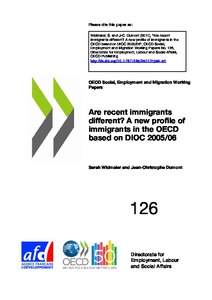Are recent immigrants different? A new profile of immigrants in the OECD based on DIOC 2005/06

Widmaier, Sarah ; Dumont, Jean-Christophe
Organisation for Economic Co-operation and Development, Paris
OECD Publishing - Paris
2011
70 p.
immigration ; level of qualification ; statistics
OECD Social, Employment and Migration Working Papers
126
Migration
English
Bibliogr.
"Increasing international migration and changing immigrant populations in OECD countries make international comparable data on migrant populations essential. These data should be updated regularly to capture a detailed picture of migrant populations. This document presents the first results of the update of the Database on Immigrants in OECD Countries (DIOC) for the years 2005/06. It describes immigrant and emigrant populations by socio-demographic characteristics and labour market outcomes in the OECD, as well as updated "brain drain" figures.
In 2005/06, 10.8% of the population in the OECD was foreign-born, representing 91 million persons. Latin American and African migrant populations increased by more than 30% between 2000 and 2005/06, slightly more than that of Asian migrants (27%). Labour market outcomes of immigrants vary by region and country of origin, but they improved significantly since 2000. In many OECD countries, low-educated foreign-born fare better on the labour market than their native-born counterparts, but high-educated migrants tend to have lower employment rates and higher unemployment rates than their native-born counterparts."
Digital
The ETUI is co-funded by the European Union. Views and opinions expressed are however those of the author(s) only and do not necessarily reflect those of the European Union or the ETUI.